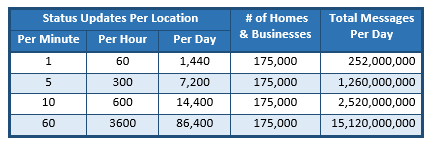With smart city initiatives, governments and utilities aim to reduce costs and resource consumption, more effectively engage with citizens and generally improve quality of life in their city.
With this in mind, consider the efforts of Manheim Germany, a city on the leading edge of smart city energy management. They use broadband over power technology to send continuous status updates between homes, businesses and the systems the power company uses to manage the supply and distribution of electricity. It’s kind of like smart grid meets smart home in one system. This data helps them allocate power where and when it is needed and also implement demand-based pricing and tariffs. The system is bidirectional so, for example, if you wanted to do a load of laundry your smart house could let you know it will be 20% cheaper if you wait a couple hours when tariffs are expected to be lower.
I thought it would be fun to approximate how many messages might be flowing through such a system. Manheim is home to approximately 315, 000 people, from which we can estimate about 150, 000 residences and 25, 000 businesses. The table below lays out the volumes, just for data collection from the endpoints. These systems tend to start with periodic updates when first implemented, say one per minute, and get more granular over time as the system gets more sophisticated.

But that’s just the beginning, because based on our experience with these kinds of applications it’s common that every “collection message” generates at least 10 back-end messages in order to store that data, start a process, calculate usage, update smart grid status, etc. That means a moderately-sized city like Manheim could be dealing with hundreds of billions of messages a day.
Now consider if this same system were in place for Berlin which is about 10 times bigger with a population of 3.4 million. That puts us into trillions of messages per day. Tokyo is about 10 times bigger still, which would mean tens of trillions.
Our “what if” analysis also factors just one use case within the realm of smart city strategy – energy. It doesn’t touch on security, transportation, water supply, waste management or healthcare. To say the scale at which smart cities will operate is staggering is a dramatic understatement.
Explore other posts from category: Use Cases

 Solace
Solace
